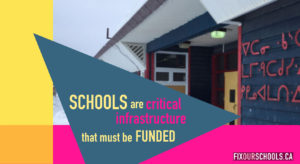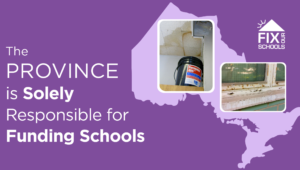MANDATES
As the Liberal Party of Ontario continues to seek input to build their party platform, leader Steven Del Duca made an interesting announcement on Monday, March 22. He said that that his Liberals would “kill Highway 413 once and for all”, and redirect the $8-billion allocated to this infrastructure project of questionable value towards additional investment in building and repairing publicly funded schools in the province. Hurrah! This could be an education mandate that the Fix Our Schools campaign could certainly get behind, and we hope that all provincial parties will prioritize school infrastructure in their platforms.
Speaking of mandates, the Globe & Mail’s revelation that the Ford government is “considering legislation that would make remote learning a permanent part of the public-school system” begs the question, “what was the PC party’s education mandate with which the Ford government was handed a majority government?” As Fix Our Schools noted back during the 2018 election, “the PC education platform was scant at best“, and made no mention of addressing the massive repair backlog in Ontario’s schools. Ford’s education mandate did, however, mention banning cell phones in class in order to maximize learning time. So, Ontario voted in a Premier that did not even want cell phones interrupting in-class learning time. Yet, after a year of emergency on-line learning, Premier Ford’s government is looking to fundamentally change the way education is delivered in this province without a mandate from the electorate, and without any understanding of the impact that this year of on-line learning has had on students.
MONEY
Why is Fix Our Schools so concerned about this proposed legislation since our focus is on ensuring all Ontario schools are safe, healthy, well-maintained buildings? Glad you asked! It is because the provincial budget delivered on March 24 provides no new money for education and schools.
MOE spox tells me 20% CARE enhancement, child benefit, increased funding of over $40m to skilled trades education and $40m for remote learning is all NEW.
GSN & PPF funding for boards is also coming, set to be released this spring, as it traditionally follows budget. #onted https://t.co/PKCriePFf6
— Travis Dhanraj (@Travisdhanraj) March 25, 2021
And so, every dollar “invested” in expanding online learning will actually take money away from school buildings, classrooms, and in-person learning. So, while Minister Lecce claims that parents want this “choice” of online learning, we must highlight that that this choice comes with a cost to the quality of in-person learning in this province.
Although, after seeing Minister Lecce try to explain the provincial budget’s impact on schools and public education, we’re not sure our Minister of Education understands how provincial funding of education actually works:
This is absolutely untrue. The Grants for Student Needs simply allocate to school boards what is provided for education in the provincial budget. It’s not extra funding. The contempt this Minister has for educators, students, and families is astounding. #onted #onpoli pic.twitter.com/hRjGYNg37r
— Catholic Teachers (@OECTAProv) March 25, 2021
Further to this confusing statement by Minister Lecce, the budget document touts that, “investments in schools are investments in the future and contribute to the long-term economic prosperity of the province”. Yes! Fix Our Schools agrees! However, then the budget document states, “this is why the government is investing about $14 billion in capital grants over 10 years to build more schools, upgrade existing facilities across Ontario and support education-related projects. This includes $1.4 billion in school renewal for the 2021–22 school year, which will ensure excellent learning environments. As part of the government’s ongoing efforts to improve and modernize infrastructure, Ontario is investing $550 million in the 2020–21 school year to build 20 new schools and eight permanent additions to existing schools.” OK. Stop right there. Are you as confused as we are about these statements?
Investing “about” $14-billion over 10 years equates to “about” $1.4-billion per year. I think we can all agree that math makes sense? What doesn’t add up is that the total amount being allocated only for school repair and renewal for 2021-22 is $1.4-billion. Yet, the budget document states that a separate amount of $550-million has been allocated for 2021-22 to build new schools and additions, which brings the total investment for 2021-22 to “about” $1.95-billion. So, if our math is correct, wouldn’t this yearly level of investment in schools require a 10-year commitment of “about” $19.5-billion, which is significantly more than the $14-billion mentioned? Does this mean that next year, we can expect a drastic cut? We’re simply not sure.
Furthermore, it is important to note that the $1.95-billion/year funding allocation for school infrastructure in 2021-22 is roughly the same amount as the previous several years. And, this level of funding has resulted in year-over-year increases in overall disrepair in Ontario schools. Therefore, with a $16.3-billion repair backlog in Ontario’s schools and no significant new funding, it is hard to imagine that $1.95-billion will somehow during this budget cycle lead to “excellent learning environments”? Again, the math used in this budget document simply does not add up to Fix Our Schools, nor does the rosy picture Minister Lecce paints of “excellent learning environments” with no new investments.
AND JUST PLAIN MEAN-SPIRITED
Fix Our Schools became aware of this 3-page memo that was sent from the Ministry of Education to all school boards on March 8, 2021, letting school boards know they are “required to display Ontario Builds signage at the site of construction that identifies the financial support of the Government of Ontario” and that “all expenses related to Ontario Builds signage, such as design, production, and installation are the responsibility of the school board. School boards are also responsible for posting the signs in a prominent, high-traffic location in a timely manner.”
This is a mean-spirited action by a government that, time and again, fails to prioritize students, schools, and our public education system. This is a provincial government that, instead, prioritizes self-promotion, and getting re-elected. Fix Our Schools would suggest that this money, time, and energy would be much better invested in actually repairing, renewing, and rebuilding Ontario’s publicly funded schools rather than on a marketing and promotion campaign for the Ford government.


